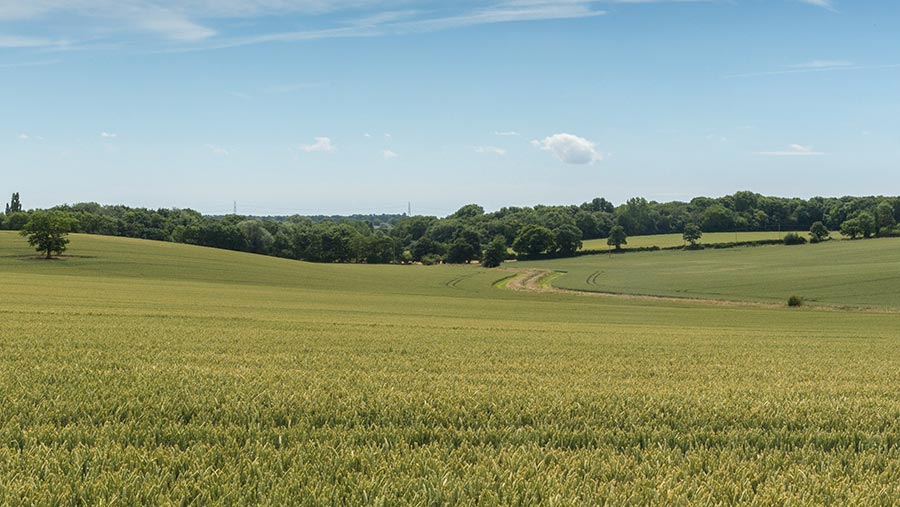7 things we know about the 2021 farmland market
 © Tim Scrivener
© Tim Scrivener Farmers are increasingly competing with non-agricultural buyers for land as forestry, environmental assets, outdoor space and privacy move up priority lists.
Conservation and climate change, additional income streams and lifestyle ambitions are driving the agricultural land market more and more.
On the other hand, supply is starting to lift, values are holding steady and farmers are as well placed as anyone to benefit from the growing interest in land’s wide-ranging benefits.
See also: How farmers can sell small blocks of land for a big return
1. Sought-after supply
The land market has seen a strong recovery after an uncertain 2020 following the effect of the initial Covid-19 lockdown.
According to Farmers Weekly’s land tracker, acreage on the open market is up 76% on this time last year, which in turn was down 65% on 2019.
The deluge of properties being launched has steadied somewhat, with the peak coming at the beginning of May, when supply was up 370% on 2020.
Ignoring the anomaly of 2020, the number of acres publicly marketed is fairly well in line with the five-year average, up about 16%.
Fisher German has reported a 10-20%-plus increase in instructions year on year, depending on location, and forecasts this to continue.
Multiple farmers have also been seeking advice on planning retirement sales, the agent says.
2. Huge demand
Interest is exceptionally high in both fully equipped, high quality farms in the right locations and holdings that offer additional income streams such as diversification or natural capital opportunities.
Forestry is in huge demand, particularly in Scotland, where the best arable land is also attracting plenty of bids and prices well above £10,000/acre are being achieved.
With the general decline in supply over the past few years, greater volume is needed to satisfy interested parties across almost every region, according to Fisher German.
The number of viewings for properties is rising year on year, showing the pent-up demand.
3. Multiple buyer types
Farmers are still the main buyers of land, but only just, according to the latest data.
Covid-19 has accelerated a move towards remote working and heightened demand for outdoor space, meaning rural property is now viewed as an increasingly desirable lifestyle asset, says Savills.
Lifestyle buyers are often leading the market, with rollover buyers also continuing to be active.
New entrants in terms of green investors – both private individuals and corporations – are also joining the pack.
4. Steady land values
Farmland has long enjoyed a reputation as a safe asset, even in times of economic difficulty, and the current market dynamics mean values should remain steady.
Strutt & Parker says it expects prices to remain solid and the agent has already experienced bidding wars this year, with two farms selling in excess of their guides.
The increased demand hasn’t yet pushed up values, although it has injected extra momentum into a market still trying to work out the implications of Brexit, according to Knight Frank.
The agent’s Farmland Index shows average values have remained flat for the past 12 months at just under £7,000/acre.
One reason to be bullish about prices is that there are still a lot of buyers with rollover money to invest, and that will only grow as the amount of development increases – a priority for the UK government.
5. Forestry focus
Evolving policy and action around the sustainability agenda have shone a light on forestry as not only a financial investment but also an environmental one, says Savills.
The annualised growth in UK timber prices was 10.6% for the five-year period to 2020-21.
Demand for woodland is exceeding supply and it is not unusual for some forests to sell for 30-70% above the asking price.
In Scotland, hill land and more marginal farmland with planting potential have seen the biggest price rises over the past five years.
Some such investors are completely new to the market. One example of this is the purchase of 9,300-acre Kinrara Estate by BrewDog. The beer business plans to plant 3 million trees and restore degraded peatlands on the estate in a bid to reach carbon negativity.
6. Environmental priorities
Savills says interest in farmland has also been building because of the role it can play in addressing the climate and biodiversity crises through new natural capital-derived revenue streams such as biodiversity net gain, water management and carbon sequestration.
Knight Frank has had more than 60 enquiries for Lavington Park, a 340-acre stud farm in West Sussex.
While many are keen on the equestrian facilities, some want to get involved with regenerative agriculture or other wildlife-friendly projects.
The agent previously sold the 28,200-acre Auch & Invermearan Estate in the southern Highlands to an overseas buyer looking to develop a landscape-scale habitat restoration project.
Interest in rewilding potential also appears to have a wide scope – Knight Frank has reportedly had three A-list Hollywood film stars get in touch this year because they want to buy a farm to rewild.
7. Popular private market
Meanwhile, private sales are growing from strength to strength, with high-profile clients, farming neighbours and rollover buyers underpinning the market.
Benefits of completing transactions without advertising include discretion, flexibility, saving time and money on marketing, and the possibility of an exclusivity premium.
Agents say there has been a surge in interest over the past 12 months due to the pandemic, following uncertainty from both buyers and sellers about the first lockdown’s effect on the open market.
These concerns appear to have been unfounded, but off-market deals are likely to remain popular, particularly for properties of £5m-plus, where the buying pool is already more limited.
